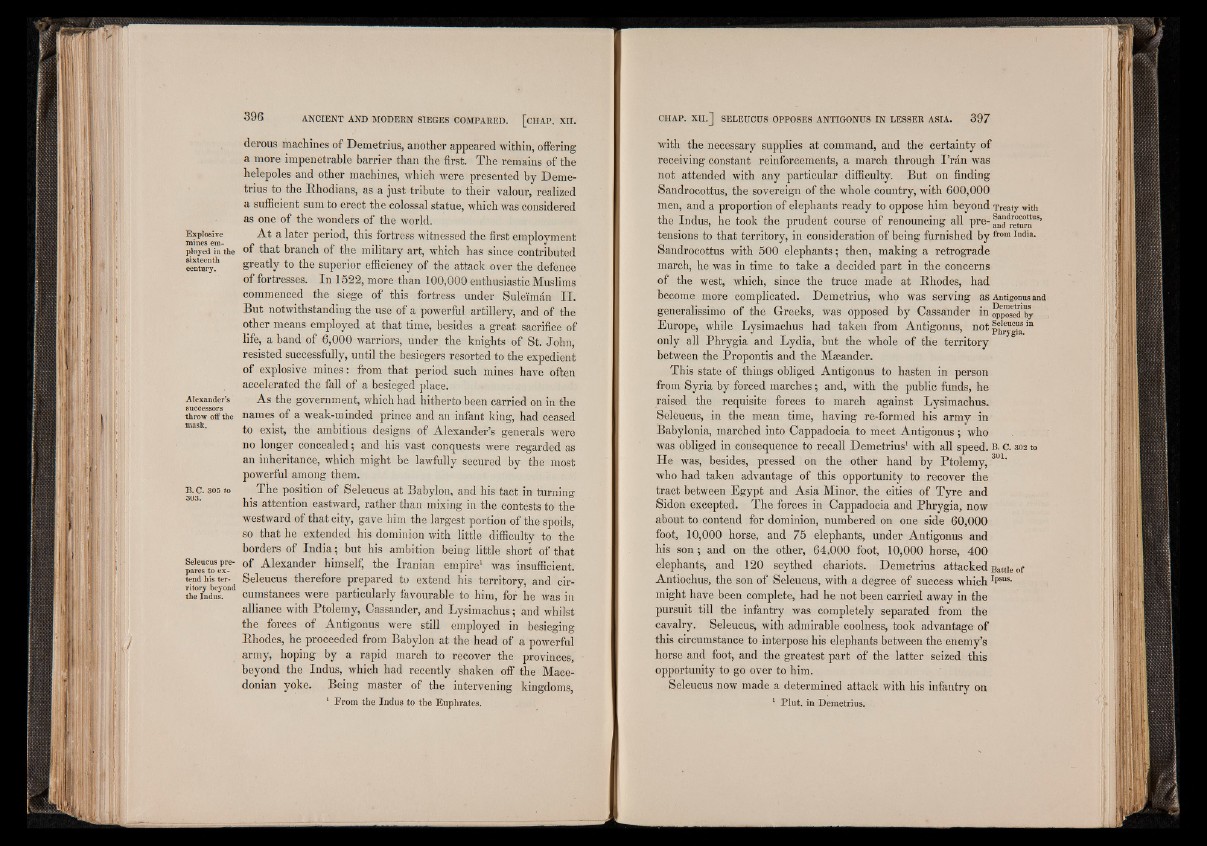
Explosive
mines employed
in the
sixteenth
century.
Alexander’s
successors
throw off the
mask.
B. C. 305 to
303.
Seleucus prepares
to extend
his territory
beyond
the Indus.
derous machines of Demetrius, another appeared within, offering
a more impenetrable barrier than the first. The remains pf the
helepoles and other machines, which were presented by Demetrius
to the Rhodians, as a just tributé to their valour, realized
a sufficient sum to erect the colossal statue, which was considered
as one of the wonders of the world.
At a later period, this fortress witnessed the first employment
of that branch of the military art, which has since contributed
greatly to the superior efficiency of the attack over the defence
of fortresses. In 1522, more than 100,000 enthusiastic Muslims
commenced the siege of this fortress under Suleimán II.
But notwithstanding the use of a powerful artillery, and of the
other means employed at that time, besides a great sacrifice of
life, a band of 6,000 warriors, under the knights of St. John,
resisted successfully, until the besiegers resorted to the expedient
of explosive mines: from that period such mines have often
accelerated the fall of a besieged place.
As the government, which had hitherto been carried on in the
names of a weak-minded prince and an infant king, had ceased
to exist, the ambitious designs of Alexander’s generals were
no longer concealed; and his vast conquests were regarded as
an inheritance, which might be lawfully secured by the most
powerful among them.
The position of Seleucus at Babylon, and his tact in turning
his attention eastward, rather than mixing in the contests to the
westward of that city, gave him the largest portion of the spoils,
so that he extended his dominion with little difficulty to the
borders of India; but his ambition being little short of that
of Alexander himself, the Iranian empire1 was insufficient.
Seleucus therefore prepared to extend his territory, and circumstances
were particularly favourable to him, for he was in
alliance with Ptolemy, Cassander, and Lysimachus; and whilst
the forces of Antigonus were still employed in besieging
Rhodes, he proceeded from Babylon at the head of a powerful
army, hoping by a rapid march to recover the provinces,
beyond the Indus, which had recently shaken off the Macedonian
yoke. Being master of the intervening kingdoms,
1 From the Indus to the Euphrates.
with the necessary supplies at command, and the certainty of
receiving constant reinforcements, a march through I ’rán was
not attended with any particular difficulty. But on finding
Sandrocottus, the sovereign of the whole country, with 600,000
men, and a proportion of elephants ready to oppose him beyond Treaty with
the Indus, he took the prudent course of renouncing all pre- ®“ drre°t“ t]us’
tensions to that territory, in consideration of being furnished by from India-
Sandrocottus with 500 elephants; then, making a retrograde
march, he was in time to take a decided part in the concerns
of the west, which, since the truce made at Rhodes, had
become more complicated. Demetrius, who was serving as Antigonus and
generalissimo of the Greeks, was opposed by Cassander in opposed by
Europe, while Lysimachus had taken from Antigonus, not|^™0“®m
only all Phrygia and Lydia, but the whole of the territory
between the Propontis and the Mseander.
This state of things obliged Antigonus to hasten in person
from Syria by forced marches; and, with the public funds, he
raised the requisite forces to march against Lysimachus.
Seleucus, in the mean time, having re-formed his army in
Babylonia, marched into Cappadocia to meet Antigonus; who
was obliged in consequence to recall Demetrius1 with all speed. B. c . 302 to
He was, besides, pressed on the other hand by Ptolemy, 301'
who had taken advantage of this opportunity to recover the
tract between Egypt and Asia Minor, the cities of Tyre and
Sidon excepted. The forces in Cappadocia and Phrygia, now
about to contend for dominion, numbered on one side 60,000
foot, 10,000 horse, and 75 elephants, under Antigonus and
his son; and on the other, 64,000 foot, 10,000 horse, 400
elephants, and 120 scythed chariots. Demetrius attacked Battie of
Antiochus, the son of Seleucus, with a degree of success whichIpsus-
might have been complete, had he not been carried away in the
pursuit till the infantry was completely separated from the
cavalry. Seleucus, with admirable coolness, took advantage of
this circumstance to interpose his elephants between the enemy’s
horse and foot, and the greatest part of the latter seized this
opportunity to go over to him.
Seleucus now made a determined attack with his infantry on
1 Plut. in Demetrius.